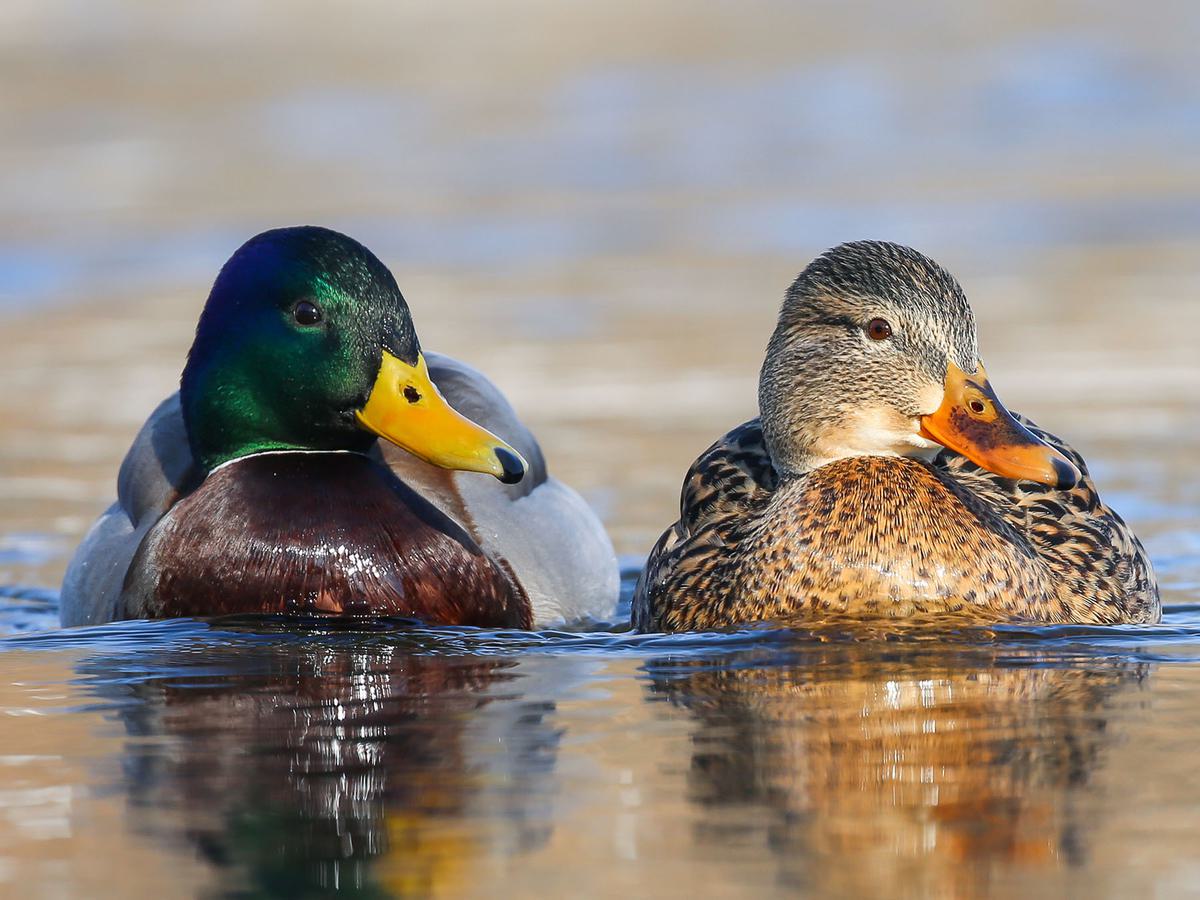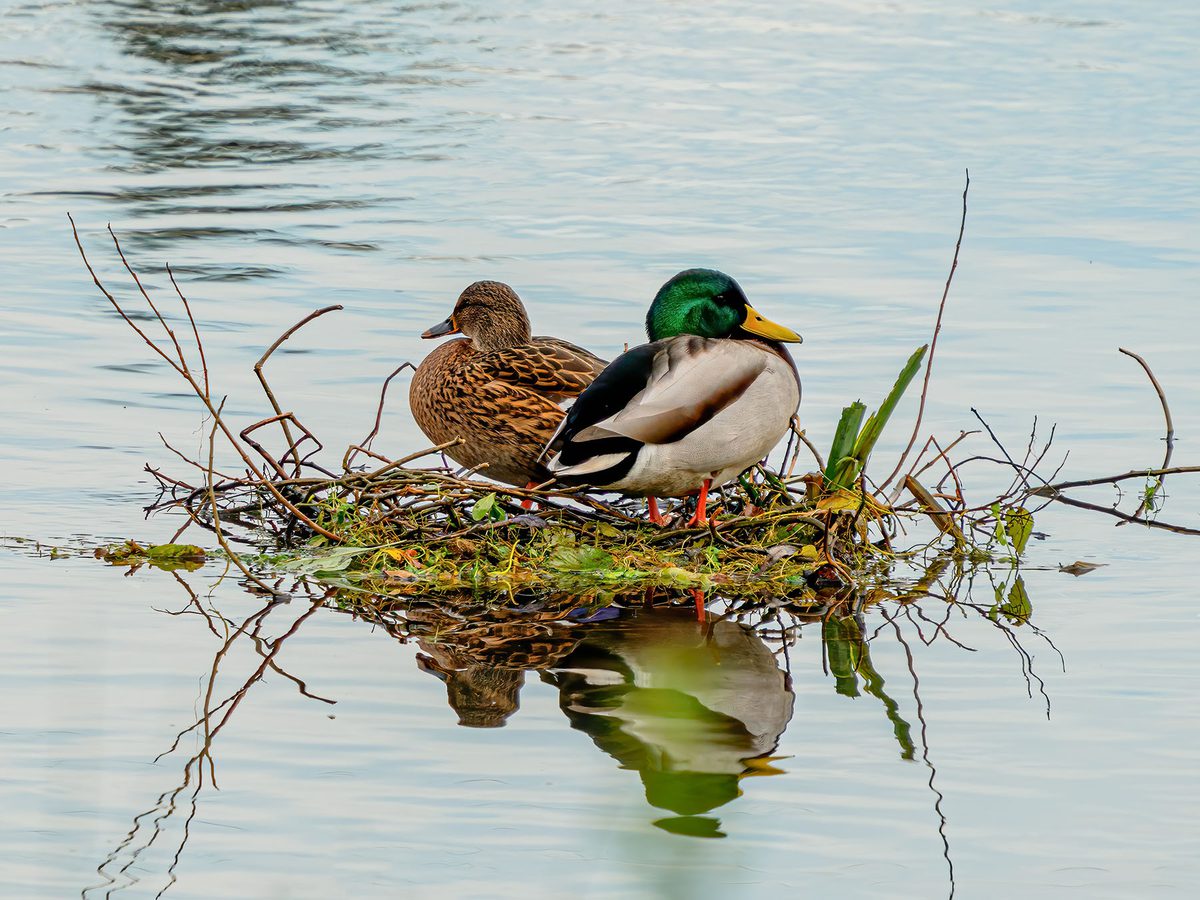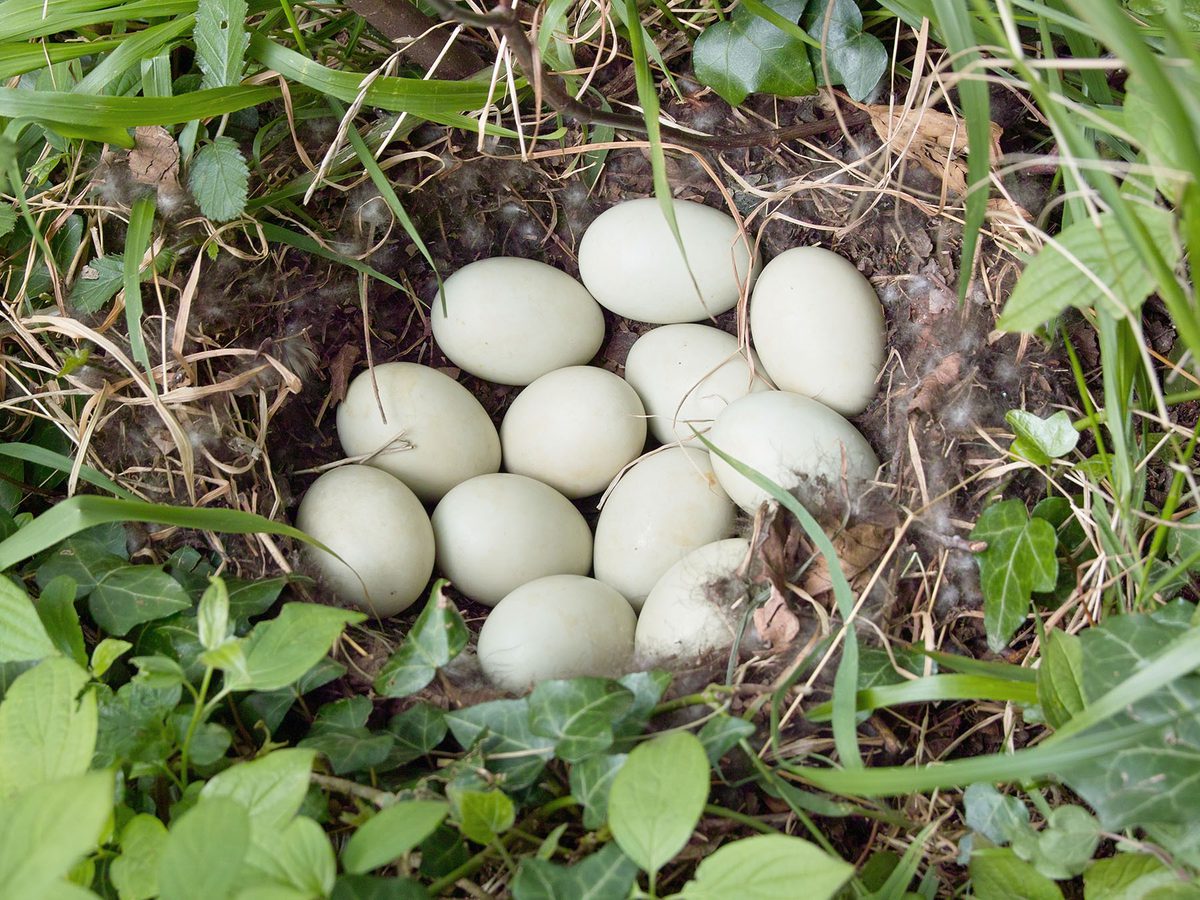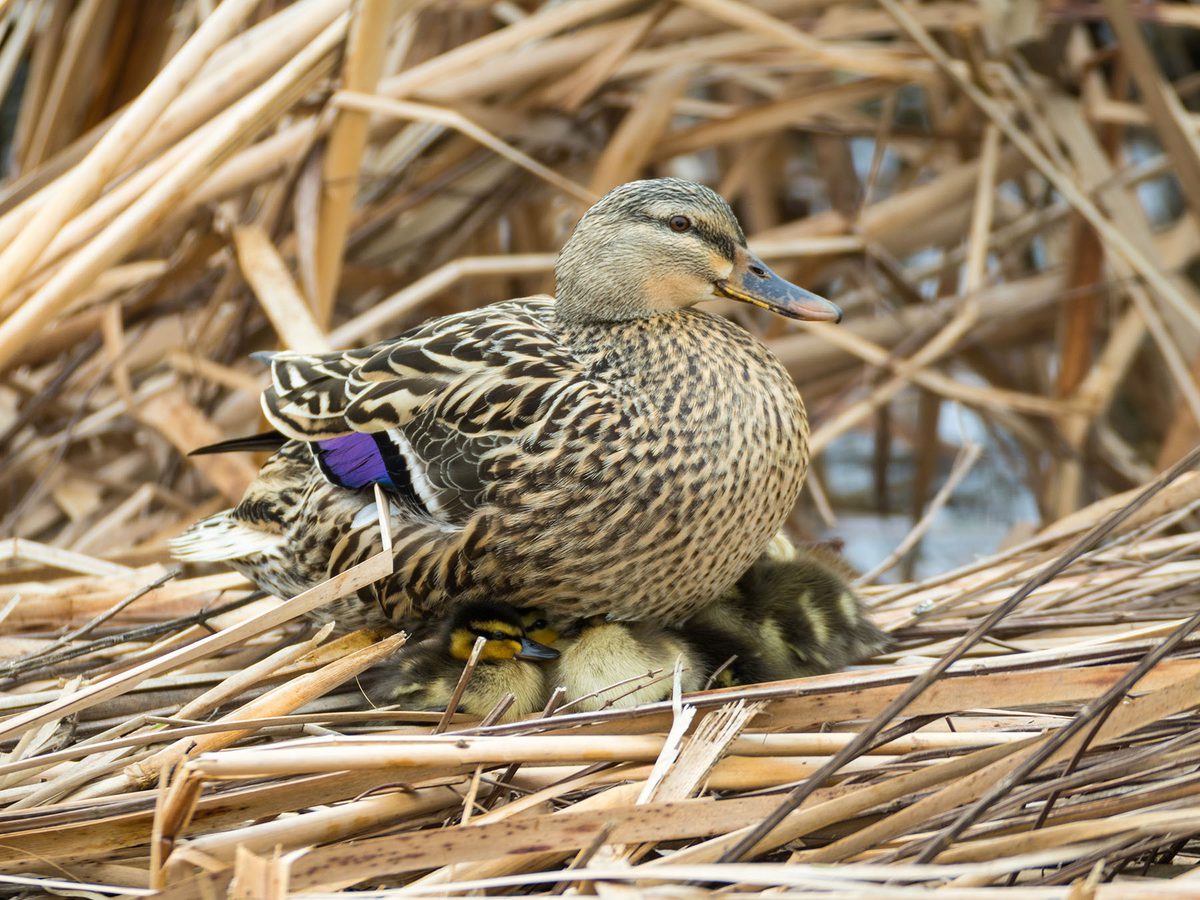The Mallard Duck (Anas platyrhynchos) is the best-known species in the Anatidae family. These attractive waterfowl are familiar as the ancestor of the modern domestic duck and a wild species of many freshwater habitats. Mallards are breeding residents and migrants across most of North America, and over the Atlantic from the UK to Japan.
Have you ever wondered where, when, and how they nest?
Mallards are generally ground-nesting birds, although they will use nest boxes. The female constructs the nest in spring or summer and lays eight to ten eggs. She incubates the eggs for about 28 days and tends to the ducklings for a further 50 to 60 days until they reach independence.
Mallards begin nesting at slightly different times across their vast geographical range. They are partially migratory in North America, visiting most of the East and Southeast in the winter only. Elsewhere in the United States and the United Kingdom, wild Mallards are breeding residents and present throughout the year.
However, birdwatchers can see nesting Mallards just about anywhere, thanks to their popularity as a domestic species. Wild and feral Mallards are not exactly your typical backyard bird, although they often nest in yards and gardens near suitable habitats.
This article covers the nesting habits of Mallards. Read along to learn where and how they build their nests, care for their eggs, and raise their young.

Female Mallard sat on her nest, incubating eggs
Nest Location
Choosing the right nest location is the first step toward raising a successful brood of Mallard ducklings. Both partners search from the air by flying low over likely areas. Read on to learn more about their favorite nesting sites.
Where do Mallards nest?
Mallard pairs usually look for a site on the ground, under dense, low vegetation or other cover. They build their nest near water and abundant food sources where the ducklings can learn to fend for themselves.
Mallards build their nests in many plants, including crops and wild grass, shrubs, and herbs. Nest sites in these open habitats are often in vegetation lower than about three feet (0.9 m), although they also nest beneath logs, in hollow trees, and in dense vegetation in wooded areas.
Look out for Mallard nests near water in the following places:
- Low vegetation
- Agricultural fields
- Under logs and other woody cover
- Woodpiles and shrubs in gardens
- Artificial structures like docks

Close up of a Mallards nest with unhatched eggs inside
Do Mallards return to the same nest?
Mallards do not usually reuse their nests, although they will nest within a few hundred yards in some areas. Where nesting sites are limited, Mallards often use old nest bowls created by other females.
Do Mallards nest in backyards?
Mallards will visit and nest in backyards, particularly near ponds and lakes. Mallards have built their nests in some pretty surprising places, including the balcony of a 9th-story apartment in Manchester, England!
Do Mallards use nest boxes?
Mallard ducks will nest in artificial nest boxes and nest ‘tubes’ made from wire and straw. They should be placed about three feet above the surface of shallow water to protect the female mallard and her eggs from predators like foxes, raccoons, coyotes, and weasels.
How high are Mallard nests?
Mallard nests are usually made at ground level, although some have made their nests a hundred and fifty feet (45 m) or more above the ground in some cases.

Female Mallard with her young ducklings
Nest Appearance
Mallard nests are usually well hidden between or under vegetation. Read on to learn more about their appearance.
What do Mallard nests look like?
The Mallard nest is a shallow bowl scraped into soft ground. It is lined with some plant material and often contains a lot of downy feathers.
How big are Mallard nests?
Mallard's nests are about the size of a large dinner plate. The inside is a cozy fit, made to match the size of the female.
These are the average dimensions of a Mallard's nest:
- Outside diameter: 11 inches (27.5 cm)
- Inside diameter: 7 inches (18 cm)
- Depth: 1 - 6 inches (2.5 - 14 cm)

Mallards nest in some pretty obscure places - this mallard is nesting under a set of stairs
Phenology
Mallards nest at the same time every year, although the exact timing depends on factors like latitude, climate, and predation. Read this section to learn when Mallard ducks nest.
What time of year do Mallards nest?
Mallards begin nesting in the spring. Their timing varies somewhat according to the latitude. In Texas, for example, Mallards start nesting in early April, while in Central Canada, nesting can begin as late as mid-June. Over in the United Kindom, Mallard nesting usually starts in March.
How long do Mallards nest for?
The Mallard nesting season can span many months. Let’s take a look at the typical timeline of a single brood:
- Egg-laying: Mallards begin to lay their eggs a day or two after completing the nest. It can take nearly two weeks for the hen to complete her clutch.
- Incubation: Mallards spend an average of four weeks sitting on their eggs, although the incubation time varies between 23 and 30 days.
- Parental care: Mallard Ducklings follow their mother for 50 to 60 days before becoming independent.
What month do Mallards lay eggs?
Mallards lay their eggs between March and July. The earliest clutches are laid furthest south, and the latest broods may be renesting attempts after predation, disturbance, or any other cause of nest failure.

A breeding pair of Mallards - male left, and female right
Nest Construction
Mallards build their nests on the ground or on other sites with a relatively level, stable base. The construction is a combination of digging, shaping, and arranging materials. Keep reading to learn how Mallards build their nests.
How do Mallards build their nests?
The Mallard Hen builds the nest by lying on her belly and digging with her feet. She will rotate herself while digging out in different directions to form a shallow bowl.
What do Mallards use for nesting?
Mallards dig out a nest bowl instead of building it up with collected material. However, the female will line the nest with grass, twigs, and leaves within reaching distance of the nest.
She will go one step further after laying her eggs by plucking out feathers from her own breast to insulate and cover her eggs.
Do male or female Mallards build the nest?
Female Mallards (hens) build the nest alone. Males do little after helping the female select a nest site, although they may maintain their bond and mate again if the first brood fails.

Nesting pair of Mallards at their nest together
Mallard Eggs
Have you ever seen a Mallard egg? Continue reading to learn about their appearance and other fascinating facts.
What do Mallard eggs look like?
Mallard eggs are unmarked with a ground color that varies from grayish to greenish or buff. The eggs are about the size of a medium chicken’s egg.
Average Mallard egg size:
- Length: 2 1⁄4 inches (58 mm)
- Width: 1 2⁄3 inches (42 mm)
- Weight: Approximately 1 5⁄6 ounces (52 g)
How many eggs do Mallards lay?
Mallards lay anything from one to thirteen eggs. The average clutch is between eight and twelve eggs.
Do male Mallards sit on eggs?
Male Mallards do not incubate the eggs or provide any care for the ducklings. However, the pair bond may persist after the female lays her eggs. In that case, males may accompany females when they take their daily breaks from incubating.

Close up of Mallard eggs in the nest
Fledgling and Parental Care
Mallard ducklings are precocial, which means they are well-developed when they hatch. Nevertheless, female Mallards are great mothers that lead their young to safety and teach them what to eat.
When do baby Mallards leave the nest?
Mallard ducklings leave the nest on their first day after hatching. They hatch fully feathered, but it takes about half a day for their feathers to dry out and to learn how to walk. They will spend the next seven or eight weeks away from the nest in the company of their mother.
How many broods do Mallards have?
Mallards usually have just one brood, although they will renest if the first brood fails. Renesting can happen more than once, and one female made five nesting attempts in a single season. Second broods are known from domesticated and feral Mallards.

Young Mallard ducklings following their mother
Mallard Nesting FAQs
Do Mallards abandon their nests?
Mallards do not readily abandon their nests, although it does happen in urban and overcrowded areas where disturbance is high. However, an incubating female Mallard will take a short break away from her brood each morning and afternoon, so a nest full of eggs and no mother has not necessarily been abandoned.
Do Mallards nest on the ground?
Mallards generally nest on the ground, although nests have been found high above the ground on multi-story buildings.
Do Mallards nest in trees?
Mallards do not usually nest in trees, although they will nest in holes at the base of trees or in forks low to the ground. Some Mallard mothers even use old nests of other birds, such as crows.

Female Mallard keeping her ducklings safe
Where do Mallards nest at night?
Mallards usually sleep on the ground. They sleep on one leg, with their heads turned back and the bill nestled between their shoulder feathers.
How to attract nesting Mallards?
Birdwatchers who live near freshwater ponds or lakes can attract nesting Mallards by putting out a nest box or nest tube.
Do mallard ducks sit on their eggs?
Female Mallard ducks sit on their eggs each day to keep the growing embryos warm. They spend nearly twenty-three hours per day incubating their eggs for up to a month before the downy ducklings hatch out.

